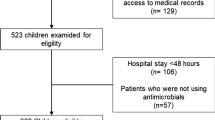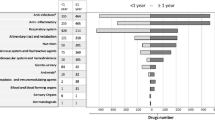Summary
Intensive monitoring of adverse drug reactions (ADR) in infants and preschool children in the paediatric outpatient unit covering the town of Karlovac (150000 inhabitants) was performed over a period of three months. Data were obtained by physical examination of children and the history given by their parents. In all 2359 children were examined. ADR were recorded in 63 children and were reported to the National ADR monitoring centre in Zagreb. Using the algorithm of Hutchinson et al. (1979), all ADR were classified as “definite”, “probable”, “possible” and “unlikely”. Drugs were prescribed in 97.3% of children, 60.24% received an antimicrobial agent (43% of them on the basis of a sensitivity test), and an antipyretic was given to 1878 children, mostly paracetamol. ADR were most frequently caused by antibiotics (49 reactions to penicillin V, and 15 to amoxycillin) and secretolytics (7 reactions). ADR were followed by complete recovery and not a single child was hospitalized because of an ADR.
The results, when compared with the very small number of broadly comparable studies, indicate that the incidence of ADR in this population is rather small and of minor importance.
Similar content being viewed by others
References
Whyte J, Greenen E (1977) Drug usage and adverse drug reactions in pediatric patients. Acta Paediatr Scand 66: 767–775
Aranda JV, Portuguez-Malavasi A, Collinge JM, Germanson T, Outerbridge EW (1982) Epidemiology of adverse drug reactions in the newborn. Dev Pharmacol Ther 5: 173–184
Rylance G (1981) Drugs in children. Br Med J 282: 50–51
Woods CG, Rylance ME, Cullen RE, Rylance GW (1987) Adverse reactions to drugs in children. Br Med J [Clin Res] 294: 869–870
Hutchinson TA, Leventhal JM, Kramer MS, Karch FE, Lipman AG, Feinstein AR (1979) An algorithm for the operational assessment of adverse drug reactions. JAMA (7): 633–638
Kramer MS, Hutchinson TA, Kenneth M, Flegel MD, Naimark L, Contardi R, Leduc DG (1985) Adverse drug reactions in general pediatric outpatients. J Pediatr 106 (2): 305–310
Sanz E, Boada J (1987) Adverse drug reactions in pediatric outpatients. Int J Clin Pharmacol Res 7 (2): 169–172
Lönnerholm G, Widerlöv E (1980) Adverse drug reactions in children. Social Epidem 3: 6–21
Mant TGK, Tempkowski JH, Volans GN, Talbot JCC (1984) Adverse reactions to acetylcysteine and effects of overdose. Br Med J 289: 217–219
Bailey DJ, Andres JM (1987) Liver injury after administration of N-acetylcysteine for meconium illeus equivalent in patient with cystic fibrosis. Pediatrics 79: 281–283
Botemman N (1984) Adverse reactions to N-acetylcysteine. Lancet 2: 228–229
Author information
Authors and Affiliations
Rights and permissions
About this article
Cite this article
Čirko-Begović, A., Vrhovac, B. & Bakran, I. Intensive monitoring of adverse drug reactions in infants and preschool children. Eur J Clin Pharmacol 36, 63–65 (1989). https://doi.org/10.1007/BF00561025
Received:
Accepted:
Issue Date:
DOI: https://doi.org/10.1007/BF00561025




